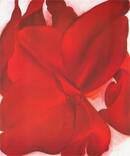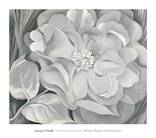Georgia O'Keeffe
Georgia O’Keeffe (1887-1986), American.
O’Keeffe is considered one of the great American artists of the 20th century, garnering recognition in both the United States and in Europe during her lifetime.
Her work is broadly accessible and yet somehow enigmatic, not easily categorized or pigeonholed.
Her use of color and form were uniquely hers and, despite a broad collection of subjects, her work is easy to recognize.
O’Keeffe was born and raised in Wisconsin. Recognizing early the talent that their daughter displayed for art, her parents encouraged her to attend art school. In 1905, O’Keeffe attended the Art Institute of Chicago and in 1907, the Art Students League in New York. Although her work was well received O’Keeffe was frustrated and spent several years teaching. In 1912, O’Keeffe started painting again, in part because of the influence of Arthur Wesley Dow. It was after this point that the O’Keeffe that modern audiences know began to emerge. In 1916, the influential photographer Alfred Stieglitz exhibited some of her work in his New York gallery. This marked the beginning of O’Keeffe’s public art career and the start of a long love affair with Stieglitz. Stieglitz introduced her to many of the American Modernists and to Lake George, which became the inspiration for several paintings.
By the middle of the 1920s, O’Keeffe had become one of the most famous and successful living American artists, commanding both high prices for her work and media attention. In 1924 she painted Petunia, No.2, and in 1927 she painted Lake George, Autumn, White Rose and Larkspur and Red Poppy. In 1929, O’Keeffe began to spend a lot of her time in New Mexico and the landscape of the desert Southwest began to infuse her work. Deer skulls and sunflowers, along with the desert horizon became her primary subject matter. During the 1940s and 50s, O’Keeffe continued to produce works of import and continued to play a role in the artistic life of America, inviting several notable figures to her home at Ghost Ranch in New Mexico, including Ansel Adams and Charles Lindbergh. While some artists seem to lose influence and admiration as the years go by, the opposite is true of O’Keeffe. Her work continues to express the confidence and authenticity of its creator and continues to touch the hearts of its viewers.
O’Keeffe was born and raised in Wisconsin. Recognizing early the talent that their daughter displayed for art, her parents encouraged her to attend art school. In 1905, O’Keeffe attended the Art Institute of Chicago and in 1907, the Art Students League in New York. Although her work was well received O’Keeffe was frustrated and spent several years teaching. In 1912, O’Keeffe started painting again, in part because of the influence of Arthur Wesley Dow. It was after this point that the O’Keeffe that modern audiences know began to emerge. In 1916, the influential photographer Alfred Stieglitz exhibited some of her work in his New York gallery. This marked the beginning of O’Keeffe’s public art career and the start of a long love affair with Stieglitz. Stieglitz introduced her to many of the American Modernists and to Lake George, which became the inspiration for several paintings.
By the middle of the 1920s, O’Keeffe had become one of the most famous and successful living American artists, commanding both high prices for her work and media attention. In 1924 she painted Petunia, No.2, and in 1927 she painted Lake George, Autumn, White Rose and Larkspur and Red Poppy. In 1929, O’Keeffe began to spend a lot of her time in New Mexico and the landscape of the desert Southwest began to infuse her work. Deer skulls and sunflowers, along with the desert horizon became her primary subject matter. During the 1940s and 50s, O’Keeffe continued to produce works of import and continued to play a role in the artistic life of America, inviting several notable figures to her home at Ghost Ranch in New Mexico, including Ansel Adams and Charles Lindbergh. While some artists seem to lose influence and admiration as the years go by, the opposite is true of O’Keeffe. Her work continues to express the confidence and authenticity of its creator and continues to touch the hearts of its viewers.

